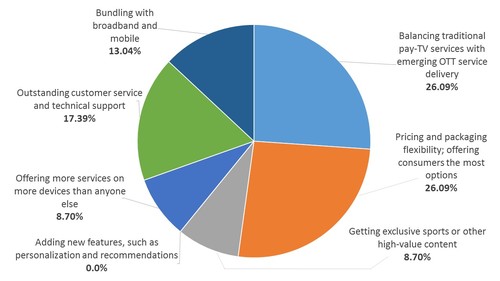|
|
|
Contributors | Messages | Polls | Resources |
|
TT Poll: Balance, Flexibility Critical for Pay-TV Providers Pay-TV providers should balance their traditional offerings with OTT distribution and offer a greater number of pricing and packaging options, according to the results of a recent poll conducted on Telco Transformation. The poll, titled What Is the Key to the Video Kingdom?, asked respondents to identify the best strategy for pay-TV providers to follow. Responses were split across multiple options, but the two leading responses were more pricing and packaging flexibility, and developing a balanced approach between OTT services and more traditional pay-TV. Pay-TV providers do face a challenge as they face growing pressure from cord-cutters, with every quarter being described as "the worst cord-cutting quarter ever." But even as younger viewers are flocking to OTT services, traditional TV viewing continues to account for the majority of video viewing time and the substantial majority of households continue to subscribe to pay-TV, at least in the US. Operators face a dilemma: should they continue to invest in a business with declining (but still substantial) revenue, or focus on developing new channels of distribution aimed at younger viewers?
What is the key to a successful video strategy for service providers?

Source: Telco Transformation Flash Poll, July-August 2017
Respondents were asked "What is the key to a successful video strategy for service providers?" Approximately one quarter of our respondents -- 26% -- said the key to a successful strategy was for pay-TV providers to balance their existing services with OTT distribution. "OTT is the future, so balancing the incumbent services with the services that are poised to take off seems to make sense," according to one respondent, though that person added "...until there's another fad to chase." However, an equal number (26%) said the key was offering more pricing and packaging options and flexibility. As one respondent put it, "To me, flexibility makes the most sense. Not all customers are going to want/demand/need/use the same services. Why cement yourself into a business model that will exclude even part of the market? For obvious reasons you can't make every package completely personal, but allowing for the most customization feasible just makes good business sense." Another 17% felt that the answer was actually improving their customer service, and that offering outstanding customer service and technical support would be the right approach for operators. According to one respondent, "I had to vote customer service because without customers nothing else matters." And another 13% felt that simply bundling TV/video services with broadband and mobile subscriptions would help operators find success. Operators are doing so, and multi-play bundles certainly have helped with driving new subscribers and cutting churn. However, in more mature markets, the bundling opportunity may have already been realized. Just under 9% of respondents felt that offering more services on more devices than anyone else was the key. And yet, not one respondent felt that offering recommendations and personalized features would help. So it's more a matter of delivering more content on more devices, rather than substantially changing the user experience, or enhancing search, discovery and navigation, that appears to be important. The same number of respondents (9%) felt content was king: they identified content as the key to operators' future success, suggesting that getting exclusive sports or other high-value content would determine success or failure for the operator. Certainly, that is a strategy several European operators are targeting, particularly around soccer rights. It does seem that our respondents are as divided on the right strategy as most TV providers. However, based on their responses, it does appear that if operators can create flexible pricing and packaging options across OTT and pay-TV, with delivery via a broad range of devices, they would be well positioned for success in coming years. Vote now in the new Telco Transformation poll, What's On Deck for SDN? — Aditya Kishore, Practice Leader, Video Transformation, Telco Transformation |
Contentious issues that are likely to fuel lawsuits and angry blogs in the coming year.
Content producers are unhappy with the advertising approach and revenues they are getting on Facebook Watch.
OTT video usage is driving the penetration of various Internet connected devices to help view online streams on the larger TV screen.
Major Hollywood studio to trial 'virtual' movie theaters using head-mounted displays.
Network technology vendor Sandvine has found that piracy isn't only hurting network operator profits – each pirated set-top box is also using up 1TB per month in 'phantom bandwidth.'
 On-the-Air Thursdays Digital Audio On-the-Air Thursdays Digital AudioARCHIVED | December 7, 2017, 12pm EST
Orange has been one of the leading proponents of SDN and NFV. In this Telco Transformation radio show, Orange's John Isch provides some perspective on his company's NFV/SDN journey.
 Special Huawei Video Special Huawei VideoHuawei Network Transformation Seminar The adoption of virtualization technology and cloud architectures by telecom network operators is now well underway but there is still a long way to go before the transition to an era of Network Functions Cloudification (NFC) is complete. |
|
|
|
||


















